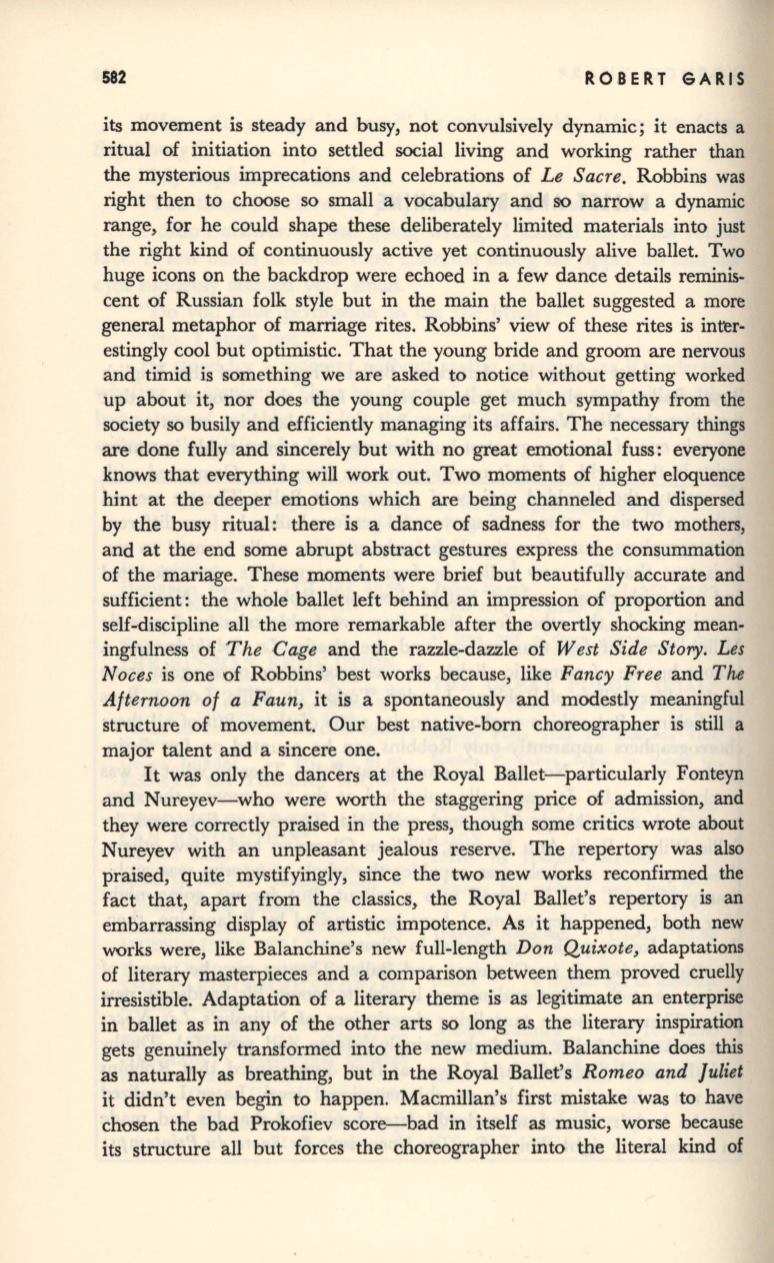
582
ROBERT GARIS
its movement is steady and busy, not convulsively dynamic; it enacts a
ritual of initiation into settled social living and working rather than
the mysterious imprecations and celebrations of
Le Sacre.
Robbins was
right then to choose so small a vocabulary and so narrow a dynamic
range, for he could shape these deliberately limited materials into just
the right kind of continuously active yet continuously alive ballet. Two
huge icons on the backdrop were echoed in a few dance details reminis–
cent of Russian folk style but in the main the ballet suggested a more
general metaphor of marriage rites. Robbins' view of these rites is inter–
estingly cool but optimistic. That the young bride and groom are nervous
and timid is something we are asked to notice without getting worked
up about it, nor does the young couple get much sympathy from the
society so busily and efficiently managing its affairs. The necessary things
are done fully and sincerely but with no great emotional fuss: everyone
knows that everything will work out. Two moments of higher eloquence
hint at the deeper emotions which are being channeled and dispersed
by the busy ritual: there is a dance of sadness for the two mothers,
and at the end some abrupt abstract gestures express the consummation
of the mariage. These moments were brief but beautifully accurate and
sufficient: the whole ballet left behind an impression of proportion and
self-discipline all the more remarkable after the overtly shocking mean–
ingfulness of
The Cage
and the razzle-dazzle of
West Side Story. Les
Noces
is one of Robbins' best works because, like
Fancy Free
and
The
Afternoon of a Faun,
it is a spontaneously and modestly meaningful
structure of movement. Our best native-born choreographer is still a
major talent and a sincere one.
It
was only the dancers at the Royal Ballet-particularly Fonteyn
and Nureyev-who were worth the staggering price of admission, and
they were correctly praised in the press, though some critics wrote about
Nureyev with an unpleasant jealous reserve. The repertory was also
praised, quite mystifyingly, since the two new works reconfirmed the
fact that, apart from the classics, the Royal Ballet's repertory is an
embarrassing display of artistic impotence. As it happened, both new
works were, like Balanchine's new full-length
Don Quixote,
adaptations
of literary masterpieces and a comparison between them proved cruelly
irresistible. Adaptation of a literary theme is as legitimate an enterprise
in ballet as in any of the other arts so long as the literary inspiration
gets genuinely transformed into the new medium. Balanchine does this
as naturally as breathing, but in the Royal Ballet's
Romeo and Juliet
it didn't even begin to happen. Macmillan's first mistake was to have
chosen the bad Prokofiev score--bad in itself as music, worse because
its structure all but forces the choreographer into the literal kind of


